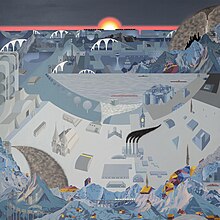Perspective (graphical)
Italian Renaissance painters and architects including Filippo Brunelleschi, Leon Battista Alberti, Masaccio, Paolo Uccello, Piero della Francesca and Luca Pacioli studied linear perspective, wrote treatises on it, and incorporated it into their artworks.[4] The earliest art paintings and drawings typically sized many objects and characters hierarchically according to their spiritual or thematic importance, not their distance from the viewer, and did not use foreshortening.[7] Systematic attempts to evolve a system of perspective are usually considered to have begun around the fifth century BC in the art of ancient Greece, as part of a developing interest in illusionism allied to theatrical scenery.[10][a] By the later periods of antiquity, artists, especially those in less popular traditions, were well aware that distant objects could be shown smaller than those close at hand for increased realism, but whether this convention was actually used in a work depended on many factors.[15] The roof beams in rooms in the Vatican Virgil, from about 400 AD, are shown converging, more or less, on a common vanishing point, but this is not systematically related to the rest of the composition.[16] Medieval artists in Europe, like those in the Islamic world and China, were aware of the general principle of varying the relative size of elements according to distance, but even more than classical art were perfectly ready to override it for other reasons.Third, in the account written by Antonio Manetti in his Vita di Ser Brunellesco at the end of the 15th century on Brunelleschi's panel, there is not a single occurrence of the word "experiment".[22][23] Soon after Brunelleschi's demonstrations, nearly every interested artist in Florence and in Italy used geometrical perspective in their paintings and sculpture,[24] notably Donatello, Masaccio,[25]Lorenzo Ghiberti, Masolino da Panicale, Paolo Uccello,[25] and Filippo Lippi.Early examples include Masolino's St. Peter Healing a Cripple and the Raising of Tabitha (c. 1423), Donatello's The Feast of Herod (c. 1427), as well as Ghiberti's Jacob and Esau and other panels from the east doors of the Florence Baptistery.Instead, he formulated the theory based on planar projections, or how the rays of light, passing from the viewer's eye to the landscape, would strike the picture plane (the painting).Della Francesca also started the now common practice of using illustrated figures to explain the mathematical concepts, making his treatise easier to understand than Alberti's.Luca Pacioli's 1509 Divina proportione (Divine Proportion), illustrated by Leonardo da Vinci, summarizes the use of perspective in painting, including much of Della Francesca's treatise.









Perspective transformKhan AcademySmarthistoryNational Gallery of Artgraphical projectiongraphic artsparallel projectionthe eyethree-dimensionaltwo-dimensionalparallelline of sightperpendicularItalian RenaissanceFilippo BrunelleschiLeon Battista AlbertiMasaccioPaolo UccelloPiero della FrancescaLuca PacioliCurvilinear perspectiveChauvet caveFrescoVilla of Publius Fannius SynistorBoscorealePompeiiSong dynastyoblique projectionLorenzetticompositionhieraticart of Ancient EgyptAncient Greekred-figure potteryart of ancient GreeceillusionismAristotlePoeticsAnaxagorasDemocritusAlcibiadesEuclidOpticsfrescoesVilla of P. Fannius SynistorWillatsAncient ChinaUkiyo-eTorii Kiyonagaruins of PompeiiPhilostratusVatican VirgilByzantine artreverse perspectiveAmbrogio LorenzettiPresentation at the TempleMasolino da PanicaleFlorentineVasariAntonio ManettiFlorence BaptisteryMelozzo da ForlìDonatelloLorenzo GhibertiFilippo LippiThe Feast of HerodHoly TrinityThe Tribute MoneyLoretoForlìToscanelliDe picturaBiagio Pelacani da ParmaAlhazenBook of OpticsPietro PeruginoDelivery of the KeysSistine ChapelDe Prospectiva pingendiPlatonic solidsDivina proportioneLeonardo da Vincishallow focusAlbrecht DürerSatire on False PerspectiveWilliam HogarthMatthias A. K. ZimmermannAnamorphosisCamera angleCutaway drawingPerspective controlTrompe-l'œilZograscopeLast Supperother cheekvertexAmerican Philosophical SocietyCucker, FelipeSUNY BuffaloLives of the ArtistsArt Institute of ChicagoEl-Bizri, NaderHendrix, John ShannonAshgate PublishingLivio, MarioBroadway BooksUniversity of St AndrewsThe Mathematical GazetteAndersen, KirstiThe Geometry of an Art: The History of the Mathematical Theory of Perspective from Alberti to MongeMIT PressPrentice-HallYale University PressBibcodeVasari, GiorgioMathematical Association of AmericaVisualizationBiological data visualizationChemical imagingCrime mappingData visualizationEducational visualizationFlow visualizationGeovisualizationInformation visualizationMathematical visualization